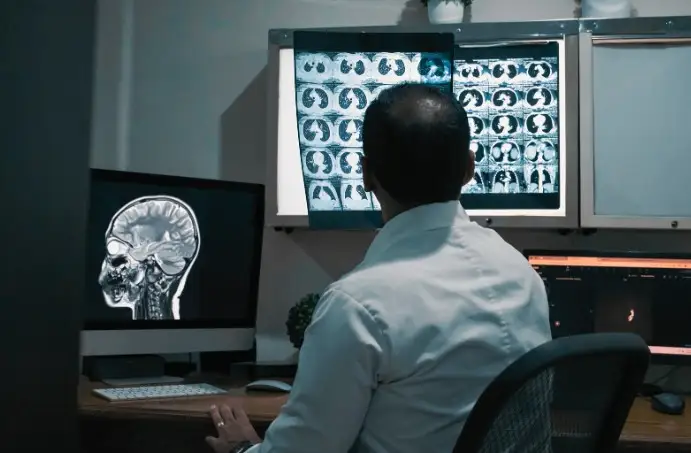What if your hospital could adapt like a startup, scaling up or down in radiology coverage, yet still maintain the reliability and integration of a full-time team?
That’s the question at the heart of locum vs employed radiologist decisions.
In 2025, this is a major strategic choice for hospitals grappling with tight budgets, rising imaging demand, and talent scarcity.
Over the next decade, demand for imaging services is projected to climb steadily, while radiologist supply shows more uncertainty. One recent projection suggests the radiology workforce will grow by about 25.7% by 2055, but imaging use may rise by 16.9% to 26.9% in the same window.
In the worst-case scenario, you’re dealing with a radiologist shortage that may affect your hospital as well. In the best-case scenario, you can leverage the oversupply to your advantage.
If you want to optimize cost, continuity, care quality, staff morale, and even legal risk, you need to pick the best hiring model for your needs. This article will walk you through:
- The definitions and key structural differences between locum and employed radiologists
- How those differences play out when it comes to cost, flexibility, quality, and compliance
- A decision framework you can lean on when making hires in 2025
- Best practices and pitfalls to watch out for
Let’s dig into what really separates these two models, and why “locum vs employed radiologist” is more than just a staffing question.
Pro tip: Need extra coverage or faster turnaround without overloading your team? Alpha Apex Group Health offers reliable teleradiology support: flexible, credentialed, and aligned with your workflow. Reach out to explore how we can help scale your radiology capacity.
The Basics: What’s the Difference Between Locum and Employed Radiologists?
Before we dive into the strategy, let’s break down the fundamentals. Understanding the key distinctions between locum and employed radiologists is the first step to hiring smarter.
Employed Radiologists: The Long-Haul Team Players
An employed radiologist is typically a full-time staff member who earns a salary. They're part of your permanent team, which means they typically receive:
- A base salary and productivity bonuses
- Benefits like health insurance, retirement contributions, and paid time off
- CME support, malpractice coverage, and administrative backing
Because they're on staff, hiring radiologists means integrating them into your culture and systems. They're there for the long run (ideally), and contribute to care continuity, team collaboration, and patient outcomes.
Locum Radiologists: The On-Demand Specialists
Locum radiologists are independent contractors (or work through staffing agencies) who fill in temporarily, whether it’s for a week, a few months, or even intermittently over the year.
They're ideal when:
- You have staffing gaps from vacations, leaves, or turnover
- Demand spikes temporarily (like when flu season strikes or you win a new contract)
- You’re in a rural or hard-to-staff region
Locums are usually paid a daily or hourly rate, and costs can include:
- Travel and lodging
- Licensing and credentialing fees
- Malpractice insurance (usually handled by the agency)
What About Credentialing Timeframes?
- Employed radiologists go through your full HR and credentialing process, which can take 60-120 days, depending on your state and medical board
- Locum providers, especially from large staffing firms, often have fast-track credentialing setups. Some can get providers cleared in as little as 30 days, particularly if your facility uses teleradiology or has credentialing reciprocity.
Here’s what you need to know.
When comparing locum vs employed radiologist options, think of it like choosing between a reliable in-house chef and a traveling Michelin-star freelancer. Both can cook, but the context and costs are totally different.
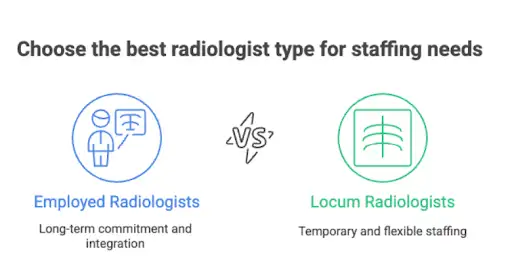
Locum vs Employed Radiologists Cost Breakdown
When comparing the cost of locum vs employed radiologists, it’s not enough to look at just hourly rates or annual salaries. The real financial picture includes everything from benefits and insurance to administrative burden and the cost of gaps in coverage.
Here’s how the two options stack up across the key areas.
Locum vs employed radiologists: Base pay and compensation
Employed radiologists are usually paid a base salary, sometimes with productivity bonuses or incentive-based pay.
According to recent data from the Bureau of Labor Statistics, full-time radiologic and MRI technologists earn a median salary of $78,980 per year. The median annual wage for magnetic resonance imaging technologists was $88,180 in May 2024.
Of course, these are just averages. In some cases, radiologists can command higher pays:
Locum radiologists command higher per-hour or per-day rates because they offer flexibility and on-demand availability. Their total pay is typically higher per shift, but they’re not on the clock year-round.
Locum vs employed radiologists: Benefits and perks
Full-time employees usually receive a full benefits package that includes health insurance, paid time off, retirement contributions, CME allowances, and more. This adds significant cost on top of their salary.
Locums, especially those who work through agencies, generally don’t receive benefits from the hospital. This simplifies your obligations but shifts that burden to the provider or their staffing firm.
Locum vs employed radiologists: Administrative and HR overhead
Hiring an employed radiologist involves recruitment, onboarding, HR compliance, annual reviews, and potentially relocation assistance.
Locums reduce some of that load, since radiology recruitment firms handle much of the logistics, but you’ll still need to manage contracts, credentialing, and short-term scheduling, which can be time-consuming if done frequently.
Locum vs employed radiologists: Malpractice insurance and legal coverage
Employed staff are usually covered under your institution’s malpractice policy or a group plan.
For locums, however, malpractice is typically provided through the staffing agency or billed separately.
Be extra careful.
In radiology, the average malpractice payment per claim can exceed US $450,000, and roughly 30% of claims are successful. That means gaps in coverage can be extremely risky.
Confirm in advance to avoid expensive surprises.
Locum vs employed radiologists: Travel, lodging, and licensing costs
With employed radiologists, these costs are usually limited to initial relocation, if any.
Locums, on the other hand, may require travel, hotel stays, meals, and licensing assistance, especially if they’re coming in from out of state. Some agencies bundle these costs into their fees, but many pass them on directly to hospitals.
Locum vs employed radiologists: Turnover, vacancy, and flexibility costs
Full-time hires provide long-term stability, but if they resign, retire, or burn out, replacing them is expensive and slow.
Locums offer plug-and-play flexibility during transitions or high-demand periods. However, you’re also exposed to the risk of short-notice cancellations or limited availability during peak times.
To put this into perspective, the UK’s NHS spent £276 million in 2023 on outsourcing, insourcing, and ad-hoc locum radiologists, money the Royal College of Radiologists noted could have funded roughly 2,690 permanent consultant posts.
What does this mean for decision makers?
- Locums cost more per hour, but can help avoid much costlier coverage gaps or backlogs
- Employed radiologists are more cost-efficient over time… if you can recruit and retain them
- The smarter move isn’t always the cheaper one upfront; it’s the one that makes the most sense with your facility’s demand pattern, retention capacity, and risk tolerance
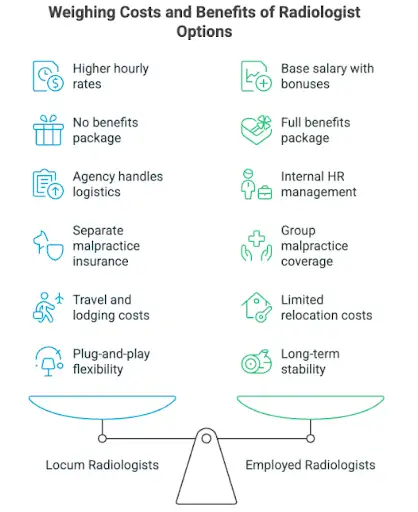
Locum vs Employed Radiologists: Flexibility vs Stability
One of the biggest differences between locum vs employed radiologists is how they fit into your workflow. This isn’t purely a matter of cost; it’s more about how adaptable your coverage needs to be.
Locum radiologists: built for flexibility
Locum radiologists give you room to breathe.
They’re ideal for:
- Short-term gaps caused by vacations, medical leave, or resignations
- Sudden spikes in imaging volume, like a flu season or trauma surges
- Hard-to-fill positions in rural or underserved areas that leave you facing shortages
- Bridging the gap during a full-time recruitment search
As a benchmark, according to CHG Healthcare’s 2023 State of Locum Tenens Report, 64% of healthcare facilities reported using locum tenens providers, mostly to maintain continuity during coverage gaps.
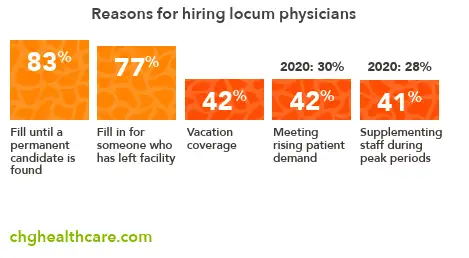
Of course, locum tenens radiologists also help you test out staffing models or new service lines without committing to a full-time hire.
Employed radiologists: the stability advantage
Employed radiologists provide consistency and deeper engagement over time. They're fully integrated into your systems and often:
- Build stronger, more sustainable working relationships with referring physicians and technologists
- Contribute to quality improvement initiatives and department strategy
- Offer better continuity of care for patients, especially in subspecialties
- Bring long-term institutional knowledge that boosts operational efficiency
If your imaging volume is steady and predictable, and if you can support a long-term hiring pipeline, employed staff might be your best bet for a stable organization.
What does this all mean?
In practice, most facilities need both flexibility and stability. Even large academic centers rely on locums to manage sabbaticals, maternity leave, or sudden spikes. But for smaller or rural hospitals with limited full-time talent pools, locums can be a great way to make up a larger share of the coverage model.
Ask yourself:
- Is our imaging volume consistent year-round or highly variable?
- How long does it take us to recruit and credential new full-time radiologists?
- Do we need specialists for short-term gaps (e.g., interventional or pediatric)?
- Are we in a region where full-time hires are tough to find?
Your answers will tell you where on the flexibility-stability spectrum you should land, and whether locums should be your safety net, your strategy, or your entire staffing model.

Locum vs Employed Radiologists: Quality of Care & Integration with Your Team
For hospitals, the locum vs employed radiologist debate isn’t just about cost and scheduling. It’s also about how well each option supports patient care, team dynamics, and long-term quality.
Locum Radiologists: Skilled but Short-Term
Locum radiologists are fully trained, board-certified professionals who can deliver high-quality reads and procedures. In fact, many are subspecialists who bring specific expertise that your team might not otherwise have access to.
The challenge here is integration. Because they’re temporary, locums usually have:
- Less familiarity with your hospital’s workflows, IT systems, or reporting templates
- Limited time to build trust with referring physicians and technologists
- Minimal involvement in long-term initiatives like quality improvement or research
That doesn’t mean locums deliver worse care, but it does mean hospitals need clear onboarding and communication protocols to help them learn your processes and culture faster.
Employed Radiologists: Continuity and Culture
Full-time staff radiologists can contribute beyond their daily reads. They:
- Strengthen collaboration with referring clinicians through ongoing relationships
- Participate in department planning, accreditation prep, and peer learning
- Build institutional memory that makes your systems run smoother over time
- Provide continuity for patients, especially in subspecialties where follow-up care is common
Continuity also reduces risk in multiple important areas. A systematic review of continuity of care in primary settings found that higher continuity is associated with reductions in mortality, hospital admissions, and emergency department visits.
Striking the Right Balance
- Locums help guarantee coverage and prevent burnout (which can reach 88% in radiology) by absorbing workload peaks
- Employed radiologists anchor culture and quality through continuity and integration
- The best outcomes tend to come from blending the two: locums for elasticity and employed staff for stability
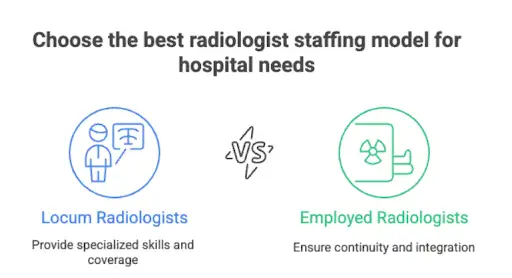
Locum vs Employed Radiologists: Credentialing, Onboarding & Turnaround Time
Even the best staffing model falls apart if you can’t get radiologists cleared and working fast. That’s where credentialing and onboarding play a huge role in the locum vs employed radiologist decision.
Employed Radiologists: A Longer Runway
Bringing on a full-time radiologist is usually a 130-day process, depending on your state’s medical board and hospital requirements. Steps include:
- Verifying licensure, education, and training
- Completing background checks and reference calls
- Privileging for hospital procedures
- HR onboarding for payroll, benefits, and compliance
The upside is once they’re in, you’ve got long-term stability. But the initial ramp-up can leave a big gap if you’re understaffed.
Locum Radiologists: Faster, But Not Instant
Locums are generally marketed as “plug and play,” and while that’s mostly true, credentialing still takes up to 60-90 days. Large staffing firms usually maintain credentialing files for their providers and may use fast-track systems with certain hospitals.
In our experience, there are cases when locums can be cleared in 30 days or less.
This is especially true if the facility has an expedited process, if they already have state licensure and prior privileges, or if telehealth coverage is in play, where credentialing reciprocity applies.
Still, if you’re bringing in locums from out of state, expect to cover licensing fees and possibly extend onboarding timelines.
So, why does speed matter?
A report from the Association of American Medical Colleges (AAMC) projected that the U.S. could face a shortage of up to 86,000 physicians by 2036, including radiology as one of the pressured specialties.
That means the ability to credential quickly is a competitive advantage. Hospitals that streamline credentialing and privileging processes are more likely to keep up with demand and avoid expensive imaging backlogs.
Takeaway for Hospital Leaders
- Expect longer lead times with employed staff, but reap long-term stability
- Locums can be faster, but plan for at least 30-45 days, especially with multi-state licensure
- Invest in strong credentialing systems now, since it’s a direct lever for reducing delays and ensuring consistent coverage
.webp)
The Legal Side of Locum vs Employed Radiologists: Contracts, Coverage, and “What Ifs”
When you’re deciding between a locum vs an employed radiologist, there’s a legal and compliance layer that hospitals can’t ignore. Think of it as the fine print that can save you from some very expensive headaches.
Contracts: who does what, exactly?
With locums, contracts have to spell out everything in detail: what hours they’ll work, what responsibilities they’re taking on, and how disputes will be handled if things go sideways.
Employed radiologists, on the other hand, usually have broader job descriptions tucked into an employment agreement. They’re more embedded in the organization, so the oversight is heavier, but the paperwork is generally simpler.
Licensing and credentialing: the gatekeeping step
Every radiologist, whether they’re full-time or temporary, has to be licensed in their state (or country) and properly credentialed by the hospital. If you skip or rush this step, you’re breaking the rules and risking regulatory sanctions or even a lawsuit if something goes wrong.
Malpractice coverage: who pays if there’s a mistake?
As we explained above, full-time radiologists are usually covered by the hospital’s malpractice insurance. Locums might be covered by their staffing agency, or they may have their own plan.
Either way, hospitals need to double-check the details: limits, coverage types, and exclusions. When you assume it’s all handled, that’s when things fall through the cracks.
Remember: Radiology is one of the more litigation-prone specialties.
When an image is missed or a diagnosis is delayed, the ripple effects can be serious. In fact, NHS data shows that radiology-related clinical claims in the U.K. rose by nearly 376% over a fourteen-year stretch. That growth highlights just how much pressure is building around diagnostic errors and delays.
The Bottom Line
Locums give you flexibility, but they also require tight contracts and careful checks on malpractice coverage. Employed staff bring stability, but you carry the full weight of liability and compliance oversight. Either way, hospitals that treat compliance as an afterthought usually pay for it later… sometimes in court.
When to Pick Locum, When to Go Employed: A Decision Framework
Deciding between a locum or an employed radiologist isn’t black-and-white. The best path depends on your hospital’s realities. Here’s how to walk someone through the decision in a conversation.
Think Through These Key Questions First
1. How predictable is your imaging volume?
If your facility sees steady, predictable demand, investing in employed radiologists usually pays off over time. If demand swings wildly, locums offer flexibility to absorb the peaks without overstaffing.
2. How fast can you recruit and credential someone new?
Employed hires can take weeks to months to onboard fully. If your facility or region has slow credentialing pipelines, locums might be your safety net.
3. What’s the local talent landscape?
In rural or less desirable locations, it’s harder to attract full-time radiologists. There, locums might form a core part of your coverage model.
4. How critical is continuity in your services?
Subspecialties, longitudinal patient follow-up, or tightly coupled care pathways benefit from continuity. If those are a central part of what you do, employed staff is easier to integrate.
5. What risks can you tolerate?
Locums reduce your fixed liability (benefits, long-term contracts), but increase variability risk (what if you can’t find one at short notice?). Employed radiologists shift more risk to you, but with more predictability.
A Simple Decision Flow (in Words)
- If your demand is stable and predictable, and you have good hiring and credential pipelines, lean towards employed radiologists
- If you expect fluctuations, or staffing gaps (turnover, leaves) are common, blend in locums as your buffer
- If your location is hard to staff, or you’re running a small facility where full-time coverage is too risky, locums might carry more weight in your model
- If continuity, culture, and integration matter a lot (for subspecialties or internal team development), use locums supplementally, not as your base.
Here’s Why This Matters
In a survey by McKinsey, about 35 % of U.S. physicians said they plan to leave their current role within five years, and many expect to exit clinical practice entirely. That’s a major turnover risk to plan around when staffing your radiology department.
So part of your decision isn’t purely about today’s gap, it’s “what’s this team going to look like in 3–5 years?” That’s exactly where a hybrid strategy (employed plus locum) can help soften shocks and make transitions easier.
Wrapping Up: What Hospitals Should Take Away
Locum vs employed radiologist isn’t a binary choice with a single right answer. It’s about matching your strategy to your hospital’s needs, risk tolerance, and long-term goals.
But after walking through definitions, costs, flexibility, quality, credentialing, legal risk, and decision frameworks, here’s what you want your leadership team to remember:
First, locums bring flexibility and speed. When someone goes on leave or resigns, or if imaging demand surges unexpectedly, locum radiologists let you plug those gaps quickly without the commitment of full-time hiring.
But the “fast and flexible” approach has trade-offs. Locums typically know your systems less well, may take time to build relationships, and sometimes aren’t too familiar with your quality standards or process goals.
On the flip side, employed radiologists bring continuity, alignment, and deeper integration with your processes. They carry the culture, remember past cases, and tend to be more invested in long-term improvements.
To choose wisely:
- Use locums when you have unpredictable demand, coverage gaps, or need specialty backfill
- Lean on employed staff when you have stable volume, want continuity, and can invest in retention
- In many cases, a hybrid model (core employees with supplemental locums) gives you both flexibility and an anchor
Here’s a stat worth keeping in mind:
In McKinsey’s “The Physician Talent Crisis” survey, 72% of physicians said they’re approached about job offers at least monthly, and, as we already know, a significant number expect to leave their current role within five years. That kind of turnover pressure means that no hospital can assume that staffing will be stable forever.
Hospitals that treat locum vs employed radiologists as a strategic lever rather than a staffing stopgap will tend to perform better.
Pro tip: Whether you need short-term coverage or a full-time hire, Alpha Apex Group Health can help. We place both locum tenens and employed radiologists with an 80%+ success rate and deliver qualified CVs straight to your inbox within 72 hours, not to mention 55% faster than the industry average.
Get in touch to see how quickly we can strengthen your team.
Frequently Asked Questions
What is a locum radiologist?
A locum radiologist is a board-certified medical professional who provides medical imaging services on a temporary or contract basis. Instead of being full-time employees of a single hospital, they move between healthcare facilities to fill coverage gaps. Locum radiologists are used across different subspecialties, including interventional radiology, breast imaging, neuroradiology, and critical care imaging. For healthcare organizations, they offer an on-demand solution when patient volumes rise or when permanent staff are unavailable.
What are the disadvantages of locum radiologists?
While locum radiology is incredibly useful for coverage, there are trade-offs, like:
- Continuity of care: Locums may not build long-term relationships with referring physicians, primary care providers, or patients
- Integration challenges: Since they move between systems, they need extra time to learn local IT, workflows, and reporting protocols
- Costs: Hourly or daily rates for locums are often higher than those of employed staff, and hospitals may also cover travel, lodging, and licensing fees
- Institutional knowledge: They’re less likely to participate in long-term projects, quality initiatives, or leadership roles within healthcare organizations
What is the difference between a doctor and a locum?
The term “doctor” (or medical provider) simply refers to a licensed clinician, whether in primary care, surgery, or a specialty like medical imaging. A “locum” isn’t a different kind of doctor; it describes the work arrangement. A locum medical professional is someone who practices on a temporary or contract basis. So a locum radiologist is still a radiologist, just one who isn’t permanently tied to a single healthcare facility.
Do locum radiologists receive medical benefits?
Typically, locum healthcare professionals do not receive medical benefits such as health insurance, retirement contributions, or paid leave from the hospital or clinic. Instead, those benefits may come through a staffing agency or must be managed independently. In contrast, employed radiologists usually receive a full benefits package as part of their compensation.
Where are locum radiologists most valuable?
Locums are especially valuable in:
- Rural healthcare facilities where recruiting permanent medical professionals is difficult
- Large hospitals that need coverage for critical care or subspecialties like interventional radiology
- Times of sudden demand (e.g., seasonal illness, staff turnover, or growing imaging volumes)
